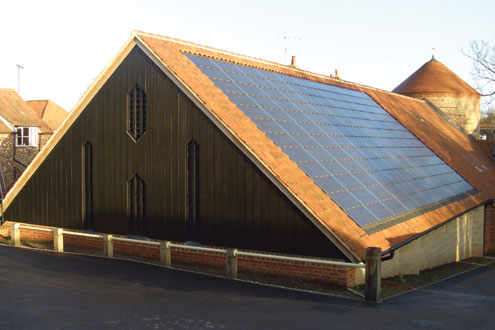In order to remain viable, react to modern living requirements and to play their part in wider sustainable development objectives; historic buildings must be able to adapt and react to new technology and innovative means of reducing energy consummation. The secret is making sure that this adaptation process does not compromise their special character and appearance.
21% of our existing housing stock was built before 1919 (one in five). The Energy Savings Trust research shows that a pre-1919 electrically heated house with poor energy-efficiency measures will leak 14.2 tonnes of CO2 annually. These pre-1919 buildings are often integral to the wider historic environment and were built using traditional methods of construction and require a more tailored series of retrofitting solutions.
Three Steps to Success
- Fabric First - the heat lost through uninsulated solid walls is typically over 50% greater than through uninsulated cavity wall so the emphasis must be focused on improving the thermal performance of the fabric. This can include, internal insulation for roof, walls and floors. Insulating breathable plaster finishes and other similar techniques. Windows and doors are another major source of heat loss, particularly when single-glazed. There are a number of specialist companies which can refurbish, reseal and re-glaze historic windows without the need for wholesale replacement and whilst working with traditional details and finishes.
- Heating and Hot Water - there are a wide range of different heating and hot water solutions that can be considered, including, air-to-air or air-to-water source heat pumps, heat phase-change materials, condensing combination boilers and mechanical heat saving devices which can all contribute to improving performance.
- Renewables - there are sympathetic renewable options which can be considered within a historic environment context. Flush fitting solar panels or solar panels sited on hidden roof slopes can provide solutions without harming external character and appearance.
Conservation and energy performance need not be at odds with each other. Indeed, many traditional materials and techniques have advantages environmentally over their modern counterparts. For example, lime uses far less energy in its production than cement. It also absorbs carbon dioxide back from the atmosphere and allows masonry units to be reclaimed when a building reaches the end of its natural life. Similarly, linseed oil paints not only protect historic surfaces for longer by allowing them to ‘breathe’, but they also lack the toxic chemicals found in many synthetic paints. There is therefore no underlying reason why historic buildings can not play their part in tackling climate change, either individually or collectively as part of a designated conservation area.
Renewables
The use of these technologies requires particular care within sensitive heritage or landscape designations. For example, within conservation areas or the Area of Outstanding Natural Beauty, only those proposals that would not adversely affect the designation, or which offer environmental benefits that outweigh the harm, will gain planning permission. In practice, this means choosing locations where the inherently modern-looking additions would not detract from the traditional or natural scene. Early talks with the LPA are therefore recommended to try and identify whether mutually acceptable solutions exist.
In addition to the above visible technologies, heat pumps and biomass boilers can also be incorporated into a design behind the scenes. The former exploit naturally occurring heat normally in the ground or from the air and efficiently convert it into a usable form for heating or cooling purposes. The latter meanwhile burn the chipped or pelletted products from forestry operations to provide both space and hot water heating. Both, however, are playing an increasingly valuable role in reducing the carbon emissions from more conventional energy sources.
Key Considerations
Examples of Inappropriate Solutions:
- Remove original single-glazed windows (e.g. sashes) and replace them with double-glazed sealed units. This not only leads to the loss of historic fabric but it will also affect the special character and appearance of the building. Completely sealing up all draughts can also increase moisture levels within the building leading to premature fabric decay.
- Seal up roof spaces with mineral wool and oil based insulation products. Not only are these unpleasant to use, but they are also non-renewable, have high embodied energy and are difficult to dispose of.
- Place solar panels and PV cells on the building’s important or prominent elevations. These modern-looking additions tend to look out of place against the mellowed, traditional facing materials and can therefore detract from the special character of the host building.
- Fix turbines prominently on chimneys or ridgelines where they can command undue attention. They can also cause structural damage in certain circumstances.
Examples of Appropriate Solutions:
- Retain, refurbish and repair the existing windows. This is inherently more sustainable than complete replacement. They can then be upgraded by introducing slimline sealed units (12mm) secondary glazing, draught stripping, shutters or even thick insulated curtains. The right balance can then be struck between minimising energy consumption and preserving historic fabric.
- Introduce organic insulation products such as wool and hemp which absorb and release moisture in equal measure. This ‘breathability’ prevents the build up of condensation in roofspaces and therefore protects historic fabric.
- Where feasible, locate panels and cells on less visible rear elevations, on new extensions or behind parapets where they will not compete visually with the host building.
- Have freestanding turbines which are sufficiently separated from the building to not impinge upon any important views of it or adversely affect its setting.
